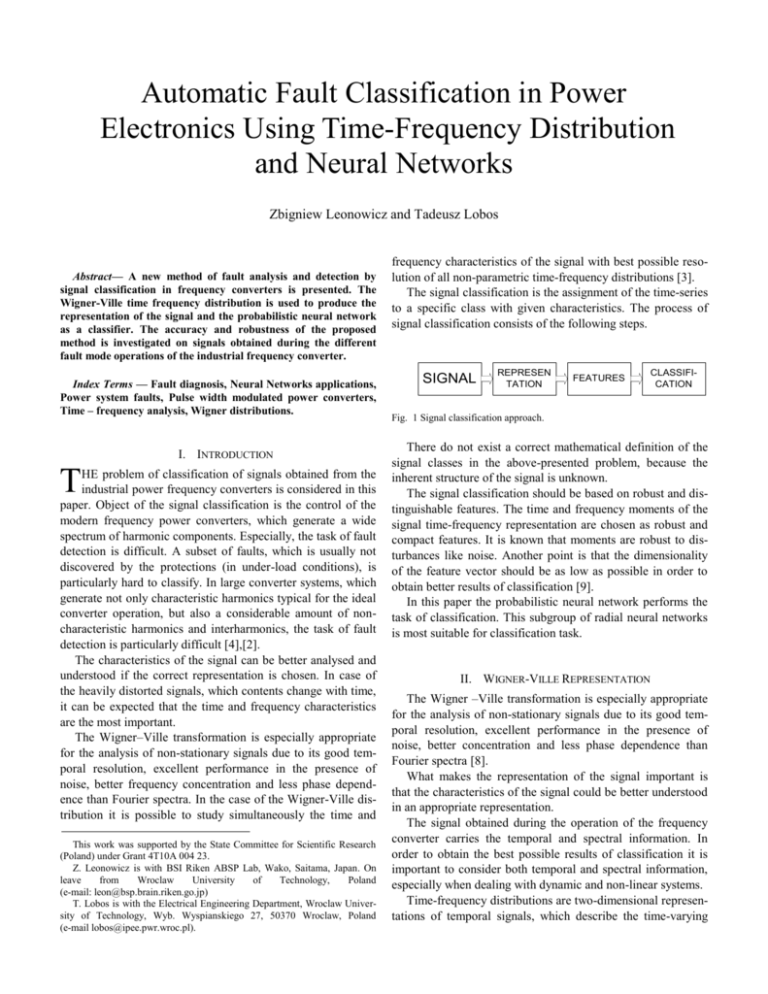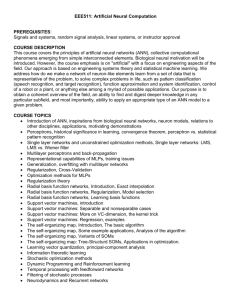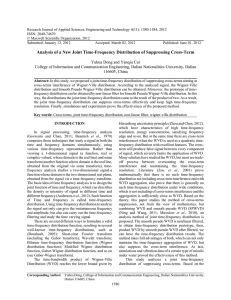ISAP-052
advertisement

Automatic Fault Classification in Power
Electronics Using Time-Frequency Distribution
and Neural Networks
Zbigniew Leonowicz and Tadeusz Lobos
Abstract— A new method of fault analysis and detection by
signal classification in frequency converters is presented. The
Wigner-Ville time frequency distribution is used to produce the
representation of the signal and the probabilistic neural network
as a classifier. The accuracy and robustness of the proposed
method is investigated on signals obtained during the different
fault mode operations of the industrial frequency converter.
Index Terms — Fault diagnosis, Neural Networks applications,
Power system faults, Pulse width modulated power converters,
Time – frequency analysis, Wigner distributions.
I. INTRODUCTION
T
HE problem of classification of signals obtained from the
industrial power frequency converters is considered in this
paper. Object of the signal classification is the control of the
modern frequency power converters, which generate a wide
spectrum of harmonic components. Especially, the task of fault
detection is difficult. A subset of faults, which is usually not
discovered by the protections (in under-load conditions), is
particularly hard to classify. In large converter systems, which
generate not only characteristic harmonics typical for the ideal
converter operation, but also a considerable amount of noncharacteristic harmonics and interharmonics, the task of fault
detection is particularly difficult [4],[2].
The characteristics of the signal can be better analysed and
understood if the correct representation is chosen. In case of
the heavily distorted signals, which contents change with time,
it can be expected that the time and frequency characteristics
are the most important.
The Wigner–Ville transformation is especially appropriate
for the analysis of non-stationary signals due to its good temporal resolution, excellent performance in the presence of
noise, better frequency concentration and less phase dependence than Fourier spectra. In the case of the Wigner-Ville distribution it is possible to study simultaneously the time and
This work was supported by the State Committee for Scientific Research
(Poland) under Grant 4T10A 004 23.
Z. Leonowicz is with BSI Riken ABSP Lab, Wako, Saitama, Japan. On
leave
from
Wroclaw
University
of
Technology,
Poland
(e-mail: leon@bsp.brain.riken.go.jp)
T. Lobos is with the Electrical Engineering Department, Wroclaw University of Technology, Wyb. Wyspianskiego 27, 50370 Wroclaw, Poland
(e-mail lobos@ipee.pwr.wroc.pl).
frequency characteristics of the signal with best possible resolution of all non-parametric time-frequency distributions [3].
The signal classification is the assignment of the time-series
to a specific class with given characteristics. The process of
signal classification consists of the following steps.
SIGNAL
REPRESEN
TATION
FEATURES
CLASSIFICATION
Fig. 1 Signal classification approach.
There do not exist a correct mathematical definition of the
signal classes in the above-presented problem, because the
inherent structure of the signal is unknown.
The signal classification should be based on robust and distinguishable features. The time and frequency moments of the
signal time-frequency representation are chosen as robust and
compact features. It is known that moments are robust to disturbances like noise. Another point is that the dimensionality
of the feature vector should be as low as possible in order to
obtain better results of classification [9].
In this paper the probabilistic neural network performs the
task of classification. This subgroup of radial neural networks
is most suitable for classification task.
II. WIGNER-VILLE REPRESENTATION
The Wigner –Ville transformation is especially appropriate
for the analysis of non-stationary signals due to its good temporal resolution, excellent performance in the presence of
noise, better concentration and less phase dependence than
Fourier spectra [8].
What makes the representation of the signal important is
that the characteristics of the signal could be better understood
in an appropriate representation.
The signal obtained during the operation of the frequency
converter carries the temporal and spectral information. In
order to obtain the best possible results of classification it is
important to consider both temporal and spectral information,
especially when dealing with dynamic and non-linear systems.
Time-frequency distributions are two-dimensional representations of temporal signals, which describe the time-varying
spectral contents of the signal. Most of the time-frequency
distributions belong to the Cohen’s Class, which members are
covariant of time and frequency shifts of the signal. It is possible to change the properties of the time-frequency distribution
by choosing the appropriate two-dimensional kernel function
, .
scribe the signal with as few variables as possible, the use of
geometric moments is proposed [1]. By using the moments, the
reduction of dimensionality is achieved without loosing the
classification accuracy.
The time and frequency moments are calculated from the
Wigner-Ville distribution of the signal.
Cx t , x t x* t
2 2
mt
(4)
t W t , dt
(5)
p
x
(1)
, e j t j u dud d
W t , d
mf
p
x
The Wigner-Ville distribution (WVD) is obtained for
, 1. It is the member of Cohen’s class with the best
resolution of all time-frequency representations [7] and is expressed by:
Wx t ,
x t x t e
2
( j )
2
d (2)
where t is a time variable, ω is a frequency variable and *
denotes complex conjugate.
For a discrete-time signal xn the discrete pseudo-WignerVille distribution (PWD) is evaluated using a sliding symmetrical finite-length analysis window h [8].
L
Wxh n, k 2 x n x (n )
L
h h e
(3)
j 4 k / N
where h is a windowing function that satisfies the condi-
tion: h 0; L . Variables n and k correspond respectively to the discrete time and frequency variables.
One main deficiency of the WVD is the cross-term interference. WVD of the sum of signal components is a linear combination of auto- and cross-terms. Each pair of the signal components creates one additional cross-term in the spectrum, thus
the desired time-frequency representation may be confusing.
Traditionally, the cross-terms are considered as something
undesired in the WVD [8] and should be removed. But, when
a cross-term is discarded, the resulting representation will
leave significant energy out. One way of lowering cross-term
interference is to apply a low-pass filter to the WVD. The
smoothing, however, will reduce the frequency resolution of
the WVD and cause the loss of many useful properties of the
transformation [7],[10].
III. MOMENTS AS FEATURES
The dimensionality problem arises when using twodimensional signal representation. For an N-point time series,
when the frequency axis of the time-frequency distribution has
M points, the signal representation has N M points. To de-
where mt is the time moment
mf is the frequency moment
t, ω are time and frequency variables
Wx is the time-frequency representation
The adequate classification requires a relatively small set of
moments [1]. For the purpose of fault signal classification we
used first and second order moments p {1, 2} .
IV. PROBABILISTIC NEURAL NETWORK
Probabilistic Neural Networks [6] as a subgroup of Radial
Basis Neural Networks are good suited for classification problems. Design of the network structure is straightforward and
does not depend on training. The network consists on an input
layer, radial basis layer and competitive layer. When an input
vector is presented, the first layer computes distances from the
input vectors to the training vectors. The first layer produces a
vector showing how close the input is close to the training data. The second layer produces a vector of probabilities, which
show how close the input vector to each trained class is. Output function picks the maximum of these probabilities and
produces true for a vector belonging to specific class and false
for other classes. The network architecture is shown in the Fig.
2.
Fig. 2 Architecture of the probabilistic neural network [6]., R – input vector,
IW - first-layer input weights, ||dist|| box produces a vector whose elements
indicate how close the input is to the vectors of the training set, Q - number
of input/target pairs = number of neurons in layer 1, K - number of classes of
input data = number of neurons in layer 2. An input vector close to a training
vector is represented by a number close to 1 in the output vector a1. LW –
second layer weights. The second-layer transfer function C (competitive)
classifies the input vector into a specific one of K classes.
V. INVESTIGATION RESULTS
A. Simulation of the fault operation
In the paper we show investigation results of a 3 kVAPWM-converter simulated with the Power System Blockset of
MATLAB® [5]. Fig. 4 shows the exemplary waveforms of the
currents at the converter output for the frequency 50 Hz during
a short circuit between phases A and B with a small fault resistance.
PWM
L
3f
~
R
C
L
Fig. 3. Simplified scheme of the simulated converter configuration. R – resistance of the short-circuit.
B. Space-phasor
The complex space-phasor of the converter output currents
is investigated using the WVD.
The motor is provided with a positive-sequence 3-phase
voltage system.
Complex space-phasor
system
f p f j f of a three-phase
f R , f S , fT is given by [3].
f
f
2
3
1 12
3
2
0
f
12 R
fS
32
fT
(6)
It describes, in addition to the positive-sequence component,
existing negative-sequence component, and harmonic and nonharmonic frequency components of the signal.
first order time moment – averaged frequency
second order time moment – frequency band
first order frequency moment – averaged time
second order frequency moment – squared time duration
The input vector of the probabilistic neural network has the
dimension 4200. Input weights (IW) (Fig. 6) are set to the
transpose of the matrix formed from the training vectors.
Training vectors are composed of eight vectors containing four
moments of the signal obtained during normal operation of the
converter and four moments of the signal obtained during the
fault operation. Target matrix contains ones in the rows corresponding to the fault operation. The second layer weights
(LW) are set to the matrix of target vectors. The competitive
layer produces ‘true’ for the largest value of the output of the
a2 vector in Fig. 2. Finally, the network classifies the input
vector into one of two classes, by choosing the class, which
has the maximum probability of being correct [6].
3-phase
SIGNAL
Spacephasor
100
IA
IB
IC
80
60
Time-frequency
representation
40
current [A]
C. Classification process
The three-phase signal representing the currents at the output of the frequency converter is combined with the help of the
equation (6) to the compact form of the complex space phasor.
Its Wigner-Ville representation is calculated. From this time
frequency representation the time and frequency moments of
the first and second order are obtained, to serve as inputs of
the probabilistic neural network. The algorithm of classification is shown in Fig. 5.
The signal at the converter output was sampled with the frequency of 20000 Hz. For the training vector the time sequence
of 200 samples was chosen. From this time sequence the Wigner-Ville distribution with dimension in time-frequency plane
equal to 200200 was calculated. As the input vectors to the
neural network served:
20
0
TIME
moments
-20
-40
FREQUENCY
moments
Probabilistic neural network
CLASSIFICATION
-60
-80
-100
0.25
Fig. 5. The classification algorithm. The three-phase signal representing the
0.3
time [s]
0.35 currents at the output of the frequency converter is combined to the form of
Fig. 4 Inverter output currents. Short-circuit between motor leads occurs at
the time point t=0.3 s.
the complex space phasor. Its Wigner-Ville representation is calculated. From
this time frequency representation the time and frequency moments of the
first and second order are obtained, to serve as inputs of the probabilistic
neural network.
For the classification process two classes of signals were investigated: signal obtained during normal operation of the inverter drive and signal obtained from the output currents of the
inverter drive during short-circuit between the motor leads
with a resistance. For each of the two signal classes 100 realizations were made.
of the classification rate. It is possible to handle the optimisation by maximising the classification rate over different kernel
designs [1]. For instance, it is possible to use the twodimensional Gaussian kernel in the form [10]:
0
1
, 1
e
0
2
2
1 0 (7)
1
e
0
Representation of the signal and properties of the timefrequency representation strongly depends on the chosen kernel , . Since it exist no simple model of the signal in
Fig. 6 Structure of trained probabilistic neural network [6]. IW – input
weights, b – bias, LW – second layer weights, C – competitive layer.
From the three-phase signal obtained from the output currents of the frequency converter a complex space phasor was
calculated, using (6). Then, the Wigner-Ville representation of
the complex space phasor was calculated, according to (3).
The classification algorithm took randomly 70 realizations
for training and the remaining 30 realizations for testing.
Before the training of the network the inputs and targets
were scaled so that they always fall in a specified range [-1,1].
An advantage of this method is the lower estimation error [11].
The results of investigations are shown in Fig. 7. The classification rate K shows the percentage of correctly identified fault
mode operation of the inverter drive for different values of the
fault resistance.
VII. CONCLUSIONS
In this paper a new method of classification of electric signals was presented, based on the time-frequency representation
and automatic signal classification with the help of probabilistic neural network. The investigations prove the validity of the
proposed approach, however this method needs further improvements to increase correct classification rate. Further work
will lead to design of the classification system with many classes, corresponding to different faults of the drive.
100
80
K [%]
question, a practical way of design of the optimal kernel can
be chosen. After the process of kernel optimisation is completed, another important step is the validation of reliability of
classification. The optimisation process must properly handle
synthetic signals with defined limit properties. Another approach to classification problem could be based on classdependent kernels, which accentuate the regions in TFD [12],
where the maximum difference between the classes of the signal occurs, or the use of adaptive neuro-fuzzy interference
system with clustering [11].
An extension of this work could be the design of a classifier
with more than two classes handling different fault mode operations of the inverter drive.
60
40
20
0
1
5
10
50
100
500
1000
R
VIII. REFERENCES
[1]
Fig. 7 Classification rate K for two class classification (fault mode operation-normal operation) for different values R [] of the fault resistance.
[2]
The classification rate using the time-frequency distribution
and probabilistic neural network averages 85% of correct classifications for input vectors other than training vectors obtained for different resistances of the short-circuit connection
between output leads of the frequency converter.
[3]
[4]
[5]
VI. POSSIBLE IMPROVEMENTS
Introduction of the optimised time-frequency distribution
based on data-dependent kernel could lead to the improvement
[6]
Baraniuk R., Jones D.: A signal dependent time-frequency representation: optimal kernel design, IEEE Trans. on Signal Processing, 41, pp.
1589-1602, 1993.
Kay S. M.: Modern spectral estimation: Theory and application, Englewood Cliffs: Prentice-Hall 1988.
Leonowicz Z., Łobos T.: Analysis of Three-Phase Signals Using Wigner
Spectrum. XVI IMEKO World Congress, Vienna 2000, vol. VI, pp.
215-220.
Łobos T., Leonowicz Z., Rezmer J.: Harmonics and Interharmonics
Estimation Using Advanced Signal Processing Methods. 9th IEEE Int.
Conf. on Harmonics and Quality of Power, Orlando (USA), 2000, vol. I,
pp. 335-340.
Łobos T., Ruhm D., Wacławek Z.: Signal analysis in converter-fed
drives using adaptive neural networks. Electr. Power Compon. Syst.
2001 vol. 29 No 2, pp.105-116
Matlab® ToolBox. Neural Networks. Radial Basis Networks, online
http://www.mathworks.com.
[7]
Martin W., Flandrin P.: Wigner-Ville Spectral Analysis of Nonstationary Processes, IEEE Trans. on Acoustics, Speech and Signal Processing, vol. 33, no. 6, pp. 1461-1470, 1985.
[8] Quian S., Chen D.: Joint Time-Frequency Analysis - Methods and Applications, Prentice-Hall, Upper Saddle River, NJ, pp. 101-131,1996
[9] Tacer B., Loughlin P.: Non-stationary signal classification using the
joint moments of time-frequency distributions, Pattern Recognition, 31
(11), 1998, pp. 1635-1641.
[10] Till M., Rudolph S.: Optimised time-frequency distributions for acoustic signal classification, Proc. SPIE Aerosense Conference on Wavelet
Applications VIII, Orlando, Florida, 2001.
Tadeusz Lobos received the M.Sc., Ph.D. and Habilitate
Doctorate (Dr Sc.) degrees, all in electrical engineering, from
the Wroclaw University of Technology, Poland.
He has been with the Department of Electrical Engineering,
Wroclaw University of Technology, since 1960, where he
became a Full Professor in 1989. From 1982 to 1986, he
worked at the University of Erlangen-Nuremberg, Germany.
His current research interests are in the areas of transients in power systems,
control and protection, and especially application of neural networks and
signal processing methods in power systems.
The Alexander von Humboldt Foundation, Germany awarded Dr. Lobos a
Research Fellowship in 1976 and he spent this fellowship at the Technical
University of Darmstadt. He received the Humboldt Research Award, Germany in 1998.
[11] Wasserman, P. D., Advanced Methods in Neural Computing, New
York: Van Nostrand Reinhold, 1993.
[12] Atlas L., Droppo J., McLaughlin J.: Optimizing Time-Frequency Distributions for Automatic Classification, Proceedings SPIE 1997, vol. 3162.
Zbigniew Leonowicz received the M.Sc. and PhD degrees
in electrical engineering from the Wroclaw University of
Technology, Poland. He has been with the Department of
Electrical Engineering since 1997. His current research
interests include modern digital signal processing methods
applied to power system analysis.
He received the NATO Advanced Fellowship in 2001 and
spent it at the Technical University of Dresden (Germany). From 2003 he is
with the Advanced Brain Signal Processing Lab., Brain Science Institute,
Riken, Wako-shi, Saitama, Japan.







